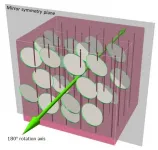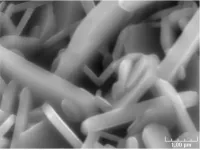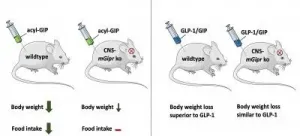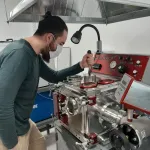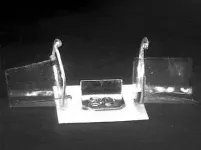(Press-News.org) A team at the University of Colorado Boulder has designed new kinds of liquid crystals that mirror the complex structures of some solid crystals--a major step forward in building flowing materials that can match the colorful diversity of forms seen in minerals and gems, from lazulite to topaz.
The group's findings, published today in the journal Nature, may one day lead to new types of smart windows and television or computer displays that can bend and control light like never before.
The results come down to a property of solid crystals that will be familiar to many chemists and gemologists: Symmetry.
Ivan Smalyukh, a professor in the Department of Physics at CU Boulder, explained that scientists categorize all known crystals into seven main classes, plus many more sub-classes--in part based on the "symmetry operations" of their internal atoms. In other words, how many ways can you stick an imaginary mirror inside of a crystal or rotate it and still see the same structure? Think of this classification system as Baskin-Robbins' 32 flavors but for minerals.
To date, however, scientists haven't been able to create liquid crystals--flowing materials that are found in most modern display technologies--that come in those same many flavors.
"We know everything about all the possible symmetries of solid crystals that we can make. There are 230 of them," said Smalyukh, senior author of the new study who is also a fellow of the Renewable and Sustainable Energy Institute (RASEI) at CU Boulder. "When it comes to nematic liquid crystals, the kind in most displays, we only have a few that have been demonstrated so far."
That is, until now.
In their latest findings, Smalyukh and his colleagues came up with a way to design the first liquid crystals that resemble monoclinic and orthorhombic crystals--two of those seven main classes of solid crystals. The findings, he said, bring a bit more of order to the chaotic world of fluids.
"There are a lot of possible types of liquid crystals, but, so far, very few have been discovered," Smalyukh said. "That is great news for students because there's a lot more to find."
Symmetry in action
To understand symmetry in crystals, first picture your body. If you place a giant mirror running down the middle of your face, you'll see a reflection that looks (more or less) like the same person.
Solid crystals have similar properties. Cubic crystals, which include diamonds and pyrite, for example, are made up of atoms arranged in the shape of a perfect cube. They have a lot of symmetry operations.
"If you rotate those crystals by 90 or 180 degrees around many special axes, for example, all of the atoms stay in the right places," Smalyukh said.
But there are other types of crystals, too. The atoms inside monoclinic crystals, which include gypsum or lazulite, are arranged in a shape that looks like a slanted column. Flip or rotate these crystals all you want, and they still have only two distinct symmetries--one mirror plane and one axis of 180-degree rotation, or the symmetry that you can see by spinning a crystal around an axis and noticing that it looks the same every 180 degrees. Scientists call that a "low-symmetry" state.
Traditional liquid crystals, however, don't display those kinds of complex structures. The most common liquid crystals, for example, are made up of tiny rod-shaped molecules. Under the microscope, they tend to line up like dry pasta noodles tossed into a pot, Smalyukh said.
"When things can flow they don't usually exhibit such low symmetries," Smalyukh said.
Order in liquids
He and his colleagues wanted to see if they could change that. To begin, the team mixed together two different kinds of liquid crystals. The first was the common class made up of rod-shaped molecules. The second was made up of particles shaped like ultra-thin disks.
When the researchers brought them together, they noticed something strange: Under the right conditions in the lab, those two types of crystals pushed and squeezed each other, changing their orientation and arrangement. The end result was a nematic liquid crystal fluid with symmetry that looks a lot like that of a solid monoclinic crystal. The molecules inside displayed some symmetry, but only one mirror plane and one axis of 180-degree rotation.
The group had created, in other words, a material with the mathematical properties of a lazulite or gypsum crystal--but theirs could flow like a fluid.
"We're asking a very fundamental question: What are the ways that you can combine order and fluidity in a single material?" Smalyukh said.
And, the team's creations are dynamic: If you heat the liquid crystals up or cool them down, for example, you can morph them into a rainbow of different structures, each with their own properties, said Haridas Mundoor, lead author of the new paper. That's pretty handy for engineers.
"This offers different avenues that can modify display technologies, which may enhance the energy efficiency in performance of devices like smart phones," said Mundoor, a postdoctoral research associate at CU Boulder.
He and his colleagues are still nowhere near making liquid crystals that can replicate the full spectrum of solid crystals. But the new paper gets them closer than ever before--good news for fans of shiny things everywhere.
INFORMATION:
Other coauthors on the new paper include Jin-Sheng (Jason) Wu, a graduate student at CU Boulder, and Henricus Wensink of the Université Paris-Saclay.
Israelis across the political spectrum prefer the status quo to the two-state solution, and Palestinians are only willing to accept a two-state solution that Israelis will be unable to accept, according to a new RAND Corporation report that assesses whether there are any alternative solutions to the conflict that average Israelis and Palestinians would support.
Derived from a series of innovative, structured focus group discussions, the report suggests that the Biden Administration's recent reaffirmation of U.S. policy to support a "mutually agreed two-state solution, one in which Israel lives in peace ...
The number of people who own electric vehicles (EVs) is increasing, but they face a conundrum: Unlike those who own gasoline-burning cars, EV owners can't just pop down to the corner gas station for a fill-up. Particularly in rural areas, charging stations can be few and far between.
Joshua Pearce, Richard Witte Endowed Professor of Materials Science and Engineering and professor of electrical and computer engineering at Michigan Technological University, hopes to change that.
In a model outlined in a paper in the journal Renewable Energy, Pearce and his co-author, graduate student Swaraj Sanjay Deshmukh, note the untapped potential of retail parking lot solar photovoltaic awnings.
The study investigates the energy-related benefits ...
A team of researchers from Immanuel Kant Baltic Federal University obtained magnetic nanoparticles using sweet flag (Acorus calamus). Both the roots and the leaves of this plant have antioxidant, antimicrobial, and insecticide properties. The extract of sweet flag was used as a non-toxic reagent for the manufacture of coated particles. The authors of the work also showed the efficiency of the new nanoparticles against several types of pathogenic fungi that damage cultivated plants. A technology developed by the team provides for the manufacture of nanoparticles from a cheap plant-based raw material and reduces the harmful effect of reagents on the environment.
Because of their unique properties, nanoparticles are used in many areas, from medicine to oil production. ...
The gram-negative bacteria Helicobacter pylori (H. pylori) colonize the stomachs of the majority of the world's population. Although most people may never experience major complications due to the pathogen, H. pylori infections increase the risk of certain types of gastric cancer, as well as other illnesses such as peptic ulcers and gastritis.
Currently, H. pylori infections are treatable with a cocktail of antibiotics, but the rapid emergence of antibiotic resistance in H. pylori is a significant concern. To counter these threats, Pushkar Lele, assistant professor in the Artie McFerrin Department of Chemical Engineering at Texas A&M University, investigated how ...
The GIP receptor in the central nervous system plays a crucial role in the regulation of body weight and food intake. This is shown by a recent study by Helmholtz Zentrum München, ETH Zurich and the German Center for Diabetes Research (DZD). The study, which has now been published in 'Cell Metabolism', identifies new targets for the development of a drug treatment for obesity and type 2 diabetes.
Dual-agonists targeting the receptors for Glucagon-like peptide 1 (GLP-1) and glucose-dependent insulinotropic polypeptide (GIP) are promising novel drug candidates for the treatment of obesity and diabetes. The new study shows how GIP decreases body weight. GIP is a hormone produced by ...
With the recent development of foldable mobile phone screens, research on foldable electronics has never been so intensive. One particularly useful application of the foldable technology is in solar panels.
Current solar cells are restricted to rigid, flat panels, which are difficult to store in large numbers and integrate into everyday appliances, including phones, windows, vehicles, or indoor devices. But, one problem prevents this formidable technology from breaking through: to be integrated into these items, solar cells need to be foldable, to bend at will repeatedly without breaking. Traditional conducting materials used in ...
MAX-phases are the new promising class of artificially created compounds that started to be extensively studied in the last two decades. They are a family of ternary layered compounds with the general formula Mn+1AXn (n = 1, 2, 3 ...), where M is an early transition metal (Sc, Ti, V, Cr, et cetera; elements from the left side of the d-block of the periodic table from group III to group VII); A -- an element from group IIIA or IVA (the most common are Al, Ga, Si, Ge); X is carbon or nitrogen, that is, the MAX phase is carbide or nitride, respectively.
Due to their structure and composition, ternary layered carbides and nitrides of d- and p-elements have a unique combination of physical properties. These compounds have high electrical and heat conductivity ...
One of the many mysteries still surrounding COVID-19 is why some people experience only mild, flu-like symptoms, whereas others suffer life-threatening respiratory problems, vascular dysfunction and tissue damage. Now, researchers reporting in ACS' Analytical Chemistry have used a combination of metabolomics and machine learning to identify possible biomarkers that could both help diagnose COVID-19 and assess the risk of developing severe illness.
Although some pre-existing conditions, such as diabetes or obesity, can increase the risk of hospitalization and death from COVID-19, some otherwise healthy people have also experienced ...
If you watch the leaves of a plant long enough, you may see them shift and turn toward the sunlight through the day. It happens slowly, but surely.
Some man-made materials can mimic this slow but steady reaction to light energy, usually triggered by lasers or focused ambient light. New research from the University of Pittsburgh and Carnegie Mellon University has discovered a way to speed up this effect enough that its performance can compete against electrical and pneumatic systems.
"We wanted to create machines where light is the only source of energy and direction," explained M. Ravi Shankar, professor of industrial engineering and senior author of the paper. "The challenge is that while we could get some movement and actuation with light-driven polymers, ...
CORVALLIS, Ore. - The Columbia River basin will see an increase in flooding over the next 50 years as a result of climate change, new modeling from Oregon State University indicates.
The magnitude of flooding - the term used to describe flooding severity - is expected to increase throughout the basin, which includes the Columbia, Willamette and Snake rivers and hundreds of tributaries. In some areas, the flooding season will expand, as well.
"The flood you're used to seeing out your window once every 10 years will likely be larger than it has been in the past," said the study's lead author, Laura Queen, a research assistant at OSU's Oregon Climate Change Research Institute. ...
